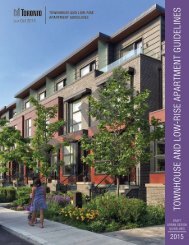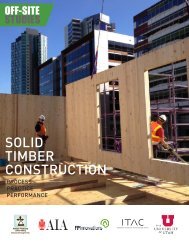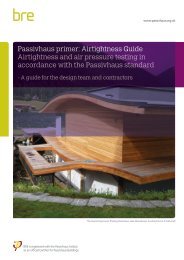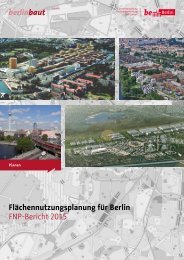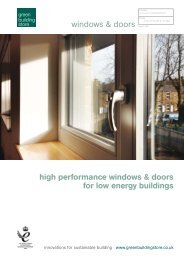TRUE URBAN SPIRIT
b008379b
b008379b
You also want an ePaper? Increase the reach of your titles
YUMPU automatically turns print PDFs into web optimized ePapers that Google loves.
4 VIENNA: NETWORKING THE CITY<br />
4.2<br />
OPEN SPACES:<br />
GREEN & <strong>URBAN</strong><br />
Squares and streets, urban parks and large-scale<br />
leisure areas are places of encounter and interaction,<br />
but also for winding down and relaxing.<br />
The design and functioning of open spaces and<br />
the way in which they meet the manifold needs<br />
of city dwellers significantly impact the quality<br />
and atmosphere of urban living and coexistence.<br />
They offer structure and identity, they enable<br />
vitality and exchange, and they shape the image<br />
of an urban quarter and of the city as a whole.<br />
Vienna is a green city, whose character is strongly<br />
influenced by woods, fields and meadows. Cultivated<br />
land – in particular vineyards – is part and<br />
parcel of these typical landscapes and serves an<br />
important leisure function. Numerous large-scale<br />
recreation zones extend around the city limits in<br />
the form of the Vienna Green Belt or, like Prater<br />
and Danube Island, form a “green lung” at the<br />
heart of the city. An extraordinary asset of Vienna<br />
lies in the fact that this metropolis hosts both a<br />
national park (Lobau – Danube Floodplains National<br />
Park) and a biosphere park (Vienna Woods).<br />
In total, Vienna’s municipal territory boasts more<br />
than 50 percent of green spaces ( Green space<br />
monitoring). This high share of green spaces is to<br />
be preserved for the future.<br />
green spaces and urban public spaces: in Grün -<br />
der zeit Vienna, the focus will be on adapting public<br />
space to a great variety of different forms of<br />
use as well on the creation of small-scale areas<br />
that offer possibilities for everyday encounters<br />
and short “breathers” (“micro open spaces”, e. g.<br />
formed by seating islands in the streetscape or<br />
sometimes by widened sidewalks). Both in centrally<br />
located newer urban quarters, such as the<br />
Nordbahnhof grounds, Vienna Main Station and<br />
in the future also the Nordwestbahnhof grounds,<br />
and in urban expansion zones like aspern Vienna’s<br />
Urban Lakeside, one task – alongside the provision<br />
of adequate open spaces – is to generate<br />
the vitality and urban quality that is a trait of<br />
fully-fledged urban neighbourhoods. Robust open<br />
spaces and attractive parks not only create a<br />
good range of green spaces for the local residential<br />
and working population, but also improve the<br />
situation for the denizens of adjoining, densely<br />
populated city quarters.<br />
To be able to adequately assess future developments<br />
and requirements, it is essential to not<br />
only look at demographic growth in general, but<br />
above all at that of population groups who, due<br />
to their situation in life, tend to use open spaces<br />
more than others. In 2025, there will be an in -<br />
crease in Viennese residents aged over 75 years<br />
by approx. 50,000 and in children and teens<br />
under 15 years by around 30,000 as compared to<br />
today. Viewed from the healthcare angle, too,<br />
both groups are dependent on public space design<br />
that takes account of their everyday needs as<br />
well as on the provision with high-quality green<br />
zones near their homes.<br />
Against this backdrop, the planning and design of<br />
squares and streets, parks and leisure zones<br />
calls for a high degree of sensitivity for the multifaceted<br />
needs as well as for differentiated understanding<br />
of the conditions and dynamics of the<br />
many diverse urban spaces.<br />
Today, green spaces are used much more intensively<br />
and in more varied ways than in the past.<br />
People take walks, exercise and relax, play, enjoy<br />
gardening and celebrate. Life on Vienna’s streets,<br />
too, has become more vibrant and diverse. This<br />
enhanced importance is also exemplified by the<br />
great variety of commercial forms of use, events<br />
and attractions. Lively ground-floor zones endow<br />
public space with renewed character. In coming<br />
years, the demographic development of different<br />
parts of the city will entail different demands for<br />
114



